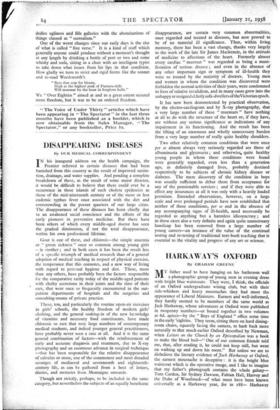DISAPPEARING DISEASES
By OUR MEDICAL CORRESPONDENT
Gout is one of these, and chlorosis—the simple anaemia or " green sickness " once so common among young girls — is another ; and in both cases it has been the result less of a specific triumph of medical research than of a general adoption of medical teaching in respect of physical exercise, the temperance that this connotes, and a new way of living with regard to personal hygiene and diet. These, more than any others, have probably been the factors responsible for the comparative rarity today of the middle-aged patients with chalky accretions in their joints and the rims of their ears, that were once so frequently encountered in the out- patient departments of hospitals and the surgeries and consulting-rooms of private practice.
These, too, and particularly the routine open-air exercises in girls' schools, the healthy freedom of modern girls' clothing, and the general soaking-in of the new knowledge of vitamins and necessary food constituents, have made chlorosis so rare that very large numbers of contemporary medical students, and indeed younger general practitioners, have probably never seen a case at all. And it is the same general combination of factors—with the reinforcement of early and accurate diagnosis and treatment, due to X-ray photography and an enormous advance in surgical technique —that has been responsible for the relative disappearance of calculus or stone, one of the commonest and most dreaded scourges of mediaeval and seventeenth and eighteenth- century life, as can be gathered from a host of letters, diaries, and memoirs from Montaigne onwards.
Though not strictly, perhaps, to be included in the same category, but nevertheless the subjects of an equally beneficent disappearance, are certain very common abnotanalities, once regarded and treated as diseases, but now proved to be of no material ill significance. Thus, within living memory, there has been a vast change, thanks very largely to the work of the late Sir James Mackenzie, in the attitude of medicine to affections of the heart. Formerly almost every cardiac " murmur " was regarded as being a mani- festation of serious disease ; and even in the absence of any other important sign or symptom of ill-health they were so treated by the majority of doctors. Young men and women in whom the condition was discovered were forbidden the normal activities of their years, were condemned to lives of relative invalidism, and in many cases grew into the unhappy or resigned elderly sofa-dwellers of theVictorian epoch.
It has now been demonstrated by practical observation, by the electro-cardiogram and by X-ray photography, that a very large number of these " murmurs " have 'nothing at all to do with the structure of the heart or, if they have, are without any serious significance as indications of any impairment in its functioning. And the result has been. the lifting of an enormous and wholly unnecessary burden from a very large number of really quite healthy shoulders.
Two other relatively common conditions that were once per se almost always very seriously regarded are those of albuminuria and glycosuria ; and otherwise, quite healthy young people in whom these conditions were found were generally regarded, even less than a generation ago, as definitely damaged lives, probably destined respectively to be subjects of chronic kidney disease or diabetes. The mere discovery of the condition in boys was usually sufficient to debar them from acceptance for any of the pensionable services ; and if they were able to effect any insurances at all it was only with a heavily loaded premium. Extended observations, however, on a large scale and over prolonged periods have now established that neither of these conditions, per se and in the absence of any accompanying signs of ill-health, need necessarily be regarded as anything but a harmless idiosyncrasy ; and in these cases also a very definite and again quite unnecessary handicap has been removed from a large number of young careers—an instance of the value of the continual testing and re-testing of traditional text-book teaching that is essential to the vitality and progress of any art or science.














































 Previous page
Previous page